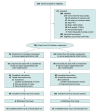Supplemental Donor Milk vs Infant Formula in Moderate to Late Preterm Infants: A Randomized Clinical Trial
- PMID: 40758360
- PMCID: PMC12322819
- DOI: 10.1001/jamapediatrics.2025.2365
Supplemental Donor Milk vs Infant Formula in Moderate to Late Preterm Infants: A Randomized Clinical Trial
Abstract
Importance: High-quality evidence supports the use of pasteurized donor human milk (donor milk) in very preterm infants with insufficient maternal milk available. However, evidence to guide the use of donor milk in more mature preterm infants is lacking.
Objective: To compare the effect of donor milk vs term infant formula, used to supplement insufficient maternal milk, on the time to establish full enteral feeds in moderate to late preterm infants.
Design, setting, and participants: This multisite, blinded randomized clinical trial was conducted from July 6, 2021, to April 5, 2023, at 2 Australian neonatal units. Infants 4 days old or younger, born between 32 + 0 and 36 + 6 weeks' gestation, with a birth weight of 1500 g or higher, and admitted to a neonatal unit were eligible if they were clinically stable, ready to commence or had commenced enteral feeds, and had insufficient maternal milk available. Infants were followed up until 6-month corrected age (CA). Follow-up assessments until 6-month CA were completed by December 4, 2023, and data analyses were completed by January 23, 2025.
Intervention: Infants were randomly assigned to receive supplemental donor milk or term formula for up to 8 days, stratified by site and gestational age at birth.
Main outcomes and measures: The primary outcome was time to full enteral feeds (defined as 150 mL/kg/day). Secondary outcomes included feed intolerance, growth, body composition, breast milk feeding, and hospital readmissions to 6-month CA.
Results: Of 201 infants randomized (99 to donor milk, 102 to formula), the mean (SD) birth gestational age was 34.6 (1.2) weeks, mean (SD) birth weight was 2267.1 (450.8) g, 88 infants (43.8%) were female, and 75 infants (37.3%) were a twin or triplet. Mean (SD) time to reach full enteral feeds did not differ between groups (donor milk group: 5.7 [2.6] days; formula group: 5.8 [3.4] days; adjusted mean difference, -0.07; 95% CI, -0.90 to 0.76). Secondary outcomes were similar between groups, except that infants in the donor milk group had a lower rate of birth weight regain compared with the formula group (mean [SD] time to regain in donor milk group: 10.7 [5.7] days; formula group: 8.4 [4.4] days; hazard ratio, 0.65; 95% CI, 0.47-0.88).
Conclusions and relevance: In this multisite randomized clinical trial, supplemental donor milk did not reduce time to full enteral feeds in moderate to late preterm infants compared with term formula for up to 8 days.
Trial registration: anzctr.org.au Identifier: ACTRN12621000529842.
Conflict of interest statement
Figures
References
Publication types
MeSH terms
LinkOut - more resources
Full Text Sources
Medical
Miscellaneous


